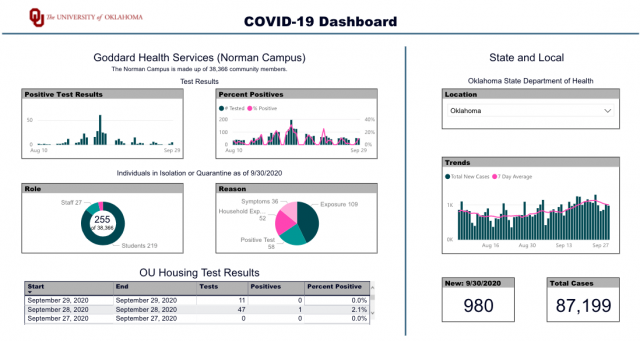To the editors:
I read through Wendy Weitzel’s article “COVID-19 on campus: An OU student shares her experience with the virus” and enjoyed the discussion of the progression of her illness. But I would like to mention the following items.
I am not aware of any students who have tested positive for COVID-19 based on classroom exposure. We do case investigation on all students who test positive, and unless there is new data that I am not aware of, every case has been linked to one of two exposures — a roommate (as in Wendy’s case) or an off-campus event where masks were not being worn. We have been watching all of the reported exposures and find that having a roommate who is positive is probably the most common route of exposure. More of those exposures are happening in off-campus housing than in on-campus housing, though that may be due to the large number of students who live off campus.
We purposely set up classrooms with six feet of physical distancing between students and faculty and require masks. Both have been shown now in multiple studies to be very effective at preventing the spread of COVID-19, because the data on transmission are now quite clear — you primarily get this infection by being close to someone in a setting where masks are not being worn and inhaling some of those invisible (to the naked eye) droplets that come out of someone else’s mouth.
The definition of a direct contact is being within six feet of someone for at least 15 minutes. That’s why we structured the classrooms as we did. Of course there is enhanced disinfection of all rooms, and the HVAC systems were modified with high efficiency filters and increased air exchange with outdoor air.
By law, all labs in the state are required to report positive tests to the state health department. So regardless of where you get tested, the data goes to the state, and then the applicable county health department is required to do contact tracing. When they call you, they find out where you currently live and then attribute the case to your current address.
That is why we carefully monitor all the new cases in the state, in Cleveland County, in Norman and in the three ZIP codes immediately around the main campus. Even if a report does not get submitted to Goddard, we see the data appear in the reports for the ZIP codes, the city, the county and the state. We are pretty sure we are not missing many cases. We are carefully monitoring the impact of the campus on the community of Norman.
Rates of absenteeism in classes is much higher than the number of positive COVID-19 cases on the Norman campus. We believe students are making conscious decisions to participate online rather than be in the classroom, for whatever reason.
Part of the reason for the backlog of screening forms a few weeks ago was that we didn’t have enough software licenses for the tool used to complete the evaluation of the forms. We now have plenty of software licenses and have hired additional staff to keep up. I think the dashboard is quite accurate now.
I want to reiterate that we all have to assume any person we encounter could have COVID-19. This is particularly true on a college campus, since at least half (and perhaps more) of college-age persons who get this infection will be asymptomatic and will look just fine. If you find yourself in settings (like a bar) where people come together without masks, you dramatically increase the risk of infection. Without a vaccine or any other known interventions to prevent the spread of COVID-19, following the public health practices of wearing a mask, maintaining physical distance (outdoor events are safer than indoor events) and doing frequent hand hygiene are the most effective strategies we have to reduce spread of the disease.
Dale W. Bratzler, DO, MPH, MACOI, FIDSA
Chief COVID Officer, University of Oklahoma
(Editor’s note: NonDoc runs Letters to the Editors between 300 words and 500 words. NonDoc reserves the right to edit lightly for length, style and grammar. We value a diverse set of voices respectfully discussing issues from different perspectives. To submit a letter for publication, please write to letters@nondoc.com.)






















